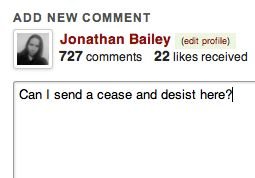Should You Send a DMCA Notice Via a Comment Form?
 This morning Torrentfreak reported on the strange case of a Spanish blogger known only as Ricardo who runs a site dedicated to the Kindle within his country.
This morning Torrentfreak reported on the strange case of a Spanish blogger known only as Ricardo who runs a site dedicated to the Kindle within his country.
Frustrated that Ken Follett’s book ‘Fall of Giants’ was not available in Spanish on the Kindle, he posted a blog entry on the topic and linked to a downloadable copy of the work available on a file hosting site. This attracted the attention of CEDRO (Spanish Reproduction Rights Center), a group that represents authors in Spain, which in turn filed a DMCA takedown notice with Ricardo and then with WordPress, which eventually took down the site temporarily and blocked Ricardo’s access.
But what makes this case unusual isn’t WordPress’ involvement, it’s how CEDRO claims to have first contacted Ricardo. According to the story, CEDRO didn’t simply email a takedown notice (or a cease and desist) and, instead, they posted it as a comment to the blog entry and, when they didn’t get a reply, they moved up the food chain.
This story raises a lot of interesting questions about sending DMCA notices (or cease and desist letters as it would more appropriately be in this case) via blog comment forms. Unfortunately for CEDRO, I think the reason it took so long for this issue to come up is because it was such a stupid idea in the first place.
Comment Fail

Back in June, I raised the question whether anyone would be willing to send a cease and desist via Twitter or Facebook. The consensus seemed to be that, though these methods of communication are becoming more commonplace, most aren’t comfortable using them for such purposes yet.
But where Twitter and Facebook come with discomfort in using them for such official capacity, comments raise still more issues.
The problem is that comments on a blog post are not necessarily directed at anyone. Where I can send a private message on Facebook or an @reply on Twitter, a comment on a blog entry is just a reply to the post and not necessarily directed at anyone. It could be at another commenter, the blog author or no one at all.
As such, it’s hard to claim that the notice was actually or effectively delivered. It’s a bit like posting the notice to a public bulletin board near a person’s home and expecting them to read it. While public notice is a part of the law, it’s for cases where the public at large, not a specific person, most be notified of something (name change, certain auctions, etc.).
While cease and desist letters and DMCA notices are not official documents in that they do not need to go through the service process, there needs to be at least some proof of receipt as ignoring these notices can have implications on a potential legal case.
It would be very difficult to prove that someone was given adequate notice with just a comment posted to their blog, especially if it is a high-volume blog.
However, that is just the tip of the iceberg with the problems with this method.
Other Problems

In addition to the obvious issues with serving any kind of notice through a comment form, there are many other reasons why a comment form would be a poor choice for such a notice.
- Spam Filtering: Though email accounts have spam filters, they seem to do a much better job eliminating false positives than comment ones, making it more likely that such a comment would be junked. Furthermore, you have two spam filters to deal with, the comment one and the email one, meaning that even if the comment goes live, the owner might not be notified.
- No Authentication: How is a blogger going to confirm who wrote a comment? With so many trolls on the Web it would be easy to dismiss such a comment as not being from a valid source, especially since the means is so uncommon. This makes it less likely the site owner will respond in a favorable way.
- It’s Public: Though no one should be ashamed of doing reasonably copyright enforcement in the public light, taking matters so pubic, especially right off the bat, basically ensures a more negative response. A polite, private message usually gets the best response.
However, the biggest issue of all is that there was no reason to file with Ricardo at all. The file host involved, MegaUpload, does respond to takedown notices and likely would have removed the work quickly. That would have cut off the problem at the source and not further downstream.
In short, rather than damming a river, they simply tried to dam one of its forks, not a good move to stop the water.
Bottom Line
To me, it almost sounds like CEDRO was trying to pick a fight. I can’t imagine a rights group with as much experience as CEDRO making a decision like this. If it were someone with no experience in enforcement, it would be an understandable mistake but this is a rights group that is no stranger to this area.
What the purpose of this was, I can not be sure. I was able to easily find Ricardo’s address (even I know what “contacto” means in Spanish) and it seems a better resolution was a simple email away. Instead now they have an ugly mess on their hands and the artist’s rights are no better protected.
All around, this seems to be a boneheaded move and one I hope other copyright holders do not repeat.
Want to Reuse or Republish this Content?
If you want to feature this article in your site, classroom or elsewhere, just let us know! We usually grant permission within 24 hours.
